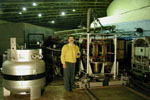|
STRUCTURE
ACTIVITIES
ACHIEVEMENTS
PUBLICATIONS
EVENTS
HISTORY
USEFUL INFORMATION
SOCIAL LIFE
|
|
 |
 |
C o n d e n s e d M a t t e r P h y s i c s
Main directions of scientific activity.
 At the PNPI there is the unique setup for the production of the polarized muons which is
the only µSR-installation in operation in Russia
( µSR
is the Muon Spin Rotation or Muon Spin Resonanse or the Muon Spin Relaxation)
[1].
At the PNPI there is the unique setup for the production of the polarized muons which is
the only µSR-installation in operation in Russia
( µSR
is the Muon Spin Rotation or Muon Spin Resonanse or the Muon Spin Relaxation)
[1].
This equipment allow to carry out the investigation of the varions materials in the temperature range from 10 K to 300 K and
in the external transverse and longitudinal magnetic fields (with respect to the muon spin direction). It should be noted that
the setup under consideration is be able to compete with the analogous ones in the worldwide scientific centers (PSI and TRIUMF).
The samples of the studyed materials (solid, liquid or friable) are enclosed into the special cryostat where the necessary temperature can be set and stabilized.
Now one carries out the number of investigations as follows
[2]:
- The effects of magnetism in the materials with the memory of shape (in the samples of the copper-manganese alloys
Cu1-xMnx –
[3].
- The random competting interaction in the alloys
Fe1-xNixÑr [4];
and (Pd0,984Fe0,016)0,95Mn0,05;
[5].
- The mutual influence of ferroelectricity and ferromagnetism:
- in the rare earth manganites (HoMnO3, YMnO3, TbMnO3) [6],
[x];
- in the alloyeged manganites La1-xAxMnO3 (A=Ca,Sr);
- in the rare earth manganates RMn2O5 (R= Eu, Gd)
[ 7,
8 ,
9 ;
10 ];
- in the rare earth orthoferrites RFeO3 (R=Ho, Y);
- in the alloyeged rare earth manganates (multiferroics) R(1-õ)CexMn2O5 (R=Eu,Gd)
[y] è
Tb0.95Bi0.05MnO3 [z];
- The properties of the nanostructure materials (the ferroliquid which is the solution of the nanodispersial
Fe3O4 or Fe2CoO4– magnetite in the D2O(H2O) -
water with the stabilizing surface-active substance
[ 11,
12,
13 ,
14 ];
making use of the different concentrations and sizes of granules [15].
- The segnetomagnetic solid solutions
(1-x)Pb(Fe2/3W1/3)O3 + xPbTiO3.
- The control of quality of the industrial steels (of the magnetic texture and the magnetic properties during the production process).
- Measuring the characteristics of muonium behavior in time (if muonium is formed in the sample under
investigation), which will allow the purity of semiconductor materials to be determined up to
an impurity content level of ~10-8 - 10-9.

|
 |
 |